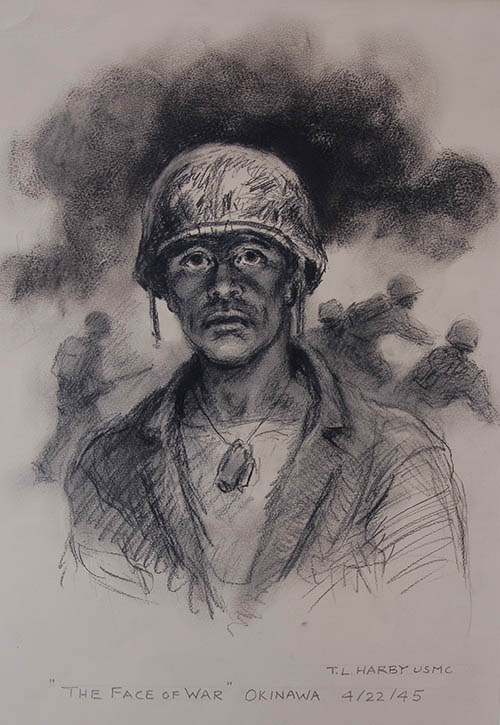Gallery show to feature WWII combat artist
UIndy professor’s father chronicled military life during Pacific campaign
WATCH: WISH-TV report with Mayor Greg Ballard
READ: Daily Journal story/interview

Okinawa, 1945
A U.S. Marine Corps combat artist’s images of military life during World War II are the focus of an exhibition opening Nov. 9 in UIndy’s Christel DeHaan Fine Arts Center Gallery.
Private First Class T.L. Harby was among more than 100 serviceman-artists assigned to combat units of the era to provide illustrations for news releases and assist in publicity efforts to generate support on the home front. He accompanied the 6th Division across the Pacific Ocean, documenting lighter moments as well as the invasion of Okinawa and the disarming of Japanese soldiers after the surrender.
“He did all the landings, all the slogging ashore,” said Harby’s son, UIndy Professor Gregory Reinhardt, who provided material from his family’s collection for the show.
Faces of War: The WWII Combat Art of T.L. (Stoney) Harby features more than 30 of Harby’s combat drawings along with photos, letters, sketch books and other memorabilia. The exhibition continues through Dec. 11 in the DeHaan Gallery, where admission is free from 9 a.m. to 9 p.m. weekdays. An opening reception is scheduled 4 to 6 p.m. Nov. 10, the 240th anniversary of the founding of the Marine Corps.
“This exhibition tells the little known story of the combat artist and the important role they’ve played throughout our military’s history,” said gallery director Mark Ruschman, who also is fine arts curator for the Indiana State Museum.
Harby was born in 1920 and grew up in Los Angeles, where his father was a city councilman. He was educated as a commercial artist but enlisted in the wake of the Pearl Harbor attack. After the war, he worked as matte artist for film studios and as a commercial portrait painter, eventually settling in Arizona and specializing in Western-inspired art under the name Stoney Harby.
Reinhardt, chair of UIndy’s Department of Anthropology, was familiar with his father’s history but had not seen much of the collection until after Harby’s death at age 90 in 2011.
“My sister and I were emptying out his apartment, and we saw all of it together,” Reinhardt recalls. “The photographer has to capture the instant, but the combat artist has the time to light and frame his scenes. You get a richer account of the incidents and the people themselves.”
After the exhibition, Harby’s work will be donated to the National Museum of the Marine Corps in Virginia.
